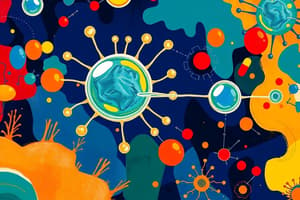Podcast
Questions and Answers
Which mechanism of action do penicillins and cephalosporins primarily utilize?
Which mechanism of action do penicillins and cephalosporins primarily utilize?
- Inhibition of DNA synthesis
- Inhibition of RNA synthesis
- Inhibition of cell wall synthesis (correct)
- Inhibition of protein synthesis
What is the role of vancomycin in bacterial treatment?
What is the role of vancomycin in bacterial treatment?
- It binds to peptidoglycan subunits (correct)
- It disrupts protein synthesis
- It inhibits RNA synthesis
- It interacts with cell membrane integrity
Which antibiotic is a structural analogue of D-alanine and is used in tuberculosis treatment?
Which antibiotic is a structural analogue of D-alanine and is used in tuberculosis treatment?
- Bacitracin
- Tetracycline
- Cycloserine (correct)
- Vancomycin
What is the primary effect of polymyxins B and E (colistin) on bacteria?
What is the primary effect of polymyxins B and E (colistin) on bacteria?
Which of the following antibiotics is known for its nephrotoxicity and neurotoxicity?
Which of the following antibiotics is known for its nephrotoxicity and neurotoxicity?
What process does bacitracin interfere with in bacterial cells?
What process does bacitracin interfere with in bacterial cells?
What type of synthesis do quinolones inhibit?
What type of synthesis do quinolones inhibit?
Which of the following antibiotics is primarily used to treat complicated skin and skin structure infections?
Which of the following antibiotics is primarily used to treat complicated skin and skin structure infections?
What is the primary distinction between bacteriostatic and bactericidal antibiotics?
What is the primary distinction between bacteriostatic and bactericidal antibiotics?
Why might a bactericidal drug be preferred in the treatment of life-threatening infections?
Why might a bactericidal drug be preferred in the treatment of life-threatening infections?
In what scenario would bacteriostatic drugs be effective in achieving clinical cure?
In what scenario would bacteriostatic drugs be effective in achieving clinical cure?
Which statement accurately reflects antibiotic classification based on their spectrum of activity?
Which statement accurately reflects antibiotic classification based on their spectrum of activity?
Which of the following is an accurate definition of antibiotics?
Which of the following is an accurate definition of antibiotics?
What is a common misconception about the use of antibiotics?
What is a common misconception about the use of antibiotics?
Which type of antibiotic would likely be considered ineffective for an immunocompromised patient with a serious infection?
Which type of antibiotic would likely be considered ineffective for an immunocompromised patient with a serious infection?
What factor should influence the choice between bacteriostatic and bactericidal drugs?
What factor should influence the choice between bacteriostatic and bactericidal drugs?
What type of antibiotics are quinolones primarily classified as?
What type of antibiotics are quinolones primarily classified as?
What role does dihydrofolate reductase play in bacterial folate synthesis?
What role does dihydrofolate reductase play in bacterial folate synthesis?
Which of the following is an example of a broad-spectrum antibiotic?
Which of the following is an example of a broad-spectrum antibiotic?
What is the primary purpose of using a narrow-spectrum antimicrobial?
What is the primary purpose of using a narrow-spectrum antimicrobial?
What type of bacteria do fluoroquinolones, such as ciprofloxacin, primarily target?
What type of bacteria do fluoroquinolones, such as ciprofloxacin, primarily target?
Which of the following best describes sulfonamides?
Which of the following best describes sulfonamides?
Why are broad-spectrum antibiotics particularly useful before pathogen identification?
Why are broad-spectrum antibiotics particularly useful before pathogen identification?
Which antibiotic mechanism involves inhibiting topoisomerase II?
Which antibiotic mechanism involves inhibiting topoisomerase II?
Why might broad-spectrum antimicrobials be chosen over narrow-spectrum drugs?
Why might broad-spectrum antimicrobials be chosen over narrow-spectrum drugs?
What is a risk associated with the long-term use of broad-spectrum antimicrobials?
What is a risk associated with the long-term use of broad-spectrum antimicrobials?
Which condition is an example of a common superinfection caused by the use of antimicrobials?
Which condition is an example of a common superinfection caused by the use of antimicrobials?
What defines empirical therapy in antibiotic treatment?
What defines empirical therapy in antibiotic treatment?
Which type of antibiotic therapy is intended for prevention rather than treatment?
Which type of antibiotic therapy is intended for prevention rather than treatment?
In which scenario should empirical antibiotic therapy be considered?
In which scenario should empirical antibiotic therapy be considered?
What is one way to confirm a bacterial infection before starting antibiotics?
What is one way to confirm a bacterial infection before starting antibiotics?
What is often recommended for antibiotic therapy to ensure safety and efficacy?
What is often recommended for antibiotic therapy to ensure safety and efficacy?
Flashcards
Antibiotics
Antibiotics
Chemical substances produced by microorganisms that inhibit or destroy other microorganisms. They can be naturally produced or synthetically manufactured.
Bacteriostatic Antibiotics
Bacteriostatic Antibiotics
Antibiotics that inhibit bacterial growth reversibly. Bacterial growth resumes once the drug is removed.
Bactericidal Antibiotics
Bactericidal Antibiotics
Antibiotics that actively kill target bacteria.
Choosing Antibiotics
Choosing Antibiotics
Signup and view all the flashcards
Antibiotic Classification - Mechanism of Action
Antibiotic Classification - Mechanism of Action
Signup and view all the flashcards
Cell Wall Synthesis Inhibitors
Cell Wall Synthesis Inhibitors
Signup and view all the flashcards
Protein Synthesis Inhibitors
Protein Synthesis Inhibitors
Signup and view all the flashcards
DNA Synthesis Inhibitors
DNA Synthesis Inhibitors
Signup and view all the flashcards
Folate Metabolism Inhibitors
Folate Metabolism Inhibitors
Signup and view all the flashcards
RNA Synthesis Inhibitors
RNA Synthesis Inhibitors
Signup and view all the flashcards
Antibiotics Targeting Cell Wall - Peptidoglycan
Antibiotics Targeting Cell Wall - Peptidoglycan
Signup and view all the flashcards
Antibiotics Targeting Cell Membrane
Antibiotics Targeting Cell Membrane
Signup and view all the flashcards
Antibiotics Targeting Ribosomes
Antibiotics Targeting Ribosomes
Signup and view all the flashcards
Antibiotics Targeting RNA Polymerase
Antibiotics Targeting RNA Polymerase
Signup and view all the flashcards
Antibiotics Targeting Topoisomerase II
Antibiotics Targeting Topoisomerase II
Signup and view all the flashcards
Sulfonamides
Sulfonamides
Signup and view all the flashcards
Trimethoprim
Trimethoprim
Signup and view all the flashcards
Narrow-Spectrum Antibiotics
Narrow-Spectrum Antibiotics
Signup and view all the flashcards
Broad-Spectrum Antibiotics
Broad-Spectrum Antibiotics
Signup and view all the flashcards
Narrow-Spectrum Use
Narrow-Spectrum Use
Signup and view all the flashcards
Broad-Spectrum Use
Broad-Spectrum Use
Signup and view all the flashcards
Broad-Spectrum Risks
Broad-Spectrum Risks
Signup and view all the flashcards
Superinfections
Superinfections
Signup and view all the flashcards
Definitive Therapy
Definitive Therapy
Signup and view all the flashcards
Empirical Therapy
Empirical Therapy
Signup and view all the flashcards
Prophylactic Therapy
Prophylactic Therapy
Signup and view all the flashcards
Study Notes
Objectives of the Lecture
- Distinguish between bacteriostatic and bactericidal activities.
- Classify antibiotics based on mechanisms of action.
- Categorize antibiotics according to their spectrum of activity.
Definition of Antibiotics
- Antibiotics are chemical substances produced by various microorganisms that inhibit or destroy other microorganisms.
- Modern antibiotics may also be chemically synthesized.
- They are ineffective against viral infections and should not be confused with antivirals.
Bacteriostatic Versus Bactericidal
- Bacteriostatic antibiotics inhibit growth reversibly; bacterial growth resumes once the drug is removed.
- Bactericidal antibiotics actively kill target bacteria.
- Choice between bacteriostatic and bactericidal depends on infection type and patient’s immune status.
- Strong immune systems can respond well to both types; immunocompromised patients often require bactericidal drugs.
- Life-threatening infections necessitate bactericidal treatment regardless of patient immune status.
Classification of Antibiotics
According to Mechanism of Action
-
Inhibition of Cell Wall Synthesis:
- Examples include penicillins, cephalosporins, and vancomycin.
-
Inhibition of Protein Synthesis:
- Examples include macrolides and tetracyclines.
-
Inhibition of DNA Synthesis:
- Quinolones, like fluoroquinolones, inhibit topoisomerase II.
-
Inhibition of Folate Metabolism:
- Sulfonamides and trimethoprim block folate synthesis crucial for nucleic acid formation.
-
Inhibition of RNA Synthesis:
- Antibiotics like rifampicin inhibit RNA polymerase.
Antibiotics Targeting Cell Wall
- Cycloserine: Inhibits alanine racemase, impacting tuberculosis treatment.
- Vancomycin: Binds to peptidoglycan precursors, disrupting cell wall assembly.
- Bacitracin: Blocks dephosphorylation of lipid carriers necessary for peptidoglycan transport.
- β-lactams (Penicillins/Cephalosporins): Form covalent bonds with penicillin-binding proteins, inhibiting cell wall cross-linking.
Antibiotics Targeting Cell Membrane
- Disrupt inner membranes, causing cell content leakage.
- Polymyxins (B and E): Used topically for Gram-negative infections; nephrotoxic.
- Daptomycin: Effective against Gram-positive bacteria for complicated skin infections.
Antibiotics Inhibiting Protein Synthesis
- Target bacterial ribosomes (50S and 30S subunits) to disrupt protein production.
Antibiotics Inhibiting RNA Synthesis
- Target RNA polymerase to impair RNA production.
Antibiotics Inhibiting DNA Synthesis
- Quinolones target topoisomerase II, blocking DNA replication in both Gram-positive and Gram-negative bacteria.
Antibiotics Inhibiting Folate Synthesis
- Sulfonamides: Mimic PABA, blocking its conversion in the folate synthesis pathway.
- Trimethoprim: Inhibits dihydrofolate reductase, vital for folate conversion.
Classification by Spectrum of Activity
- Narrow-Spectrum Antibiotics: Target specific bacterial subsets (e.g., penicillin G for Gram-positive).
- Broad-Spectrum Antibiotics: Effective against a wide variety of bacteria (e.g., ampicillin).
Spectrum of Activity: Key Insights
- Narrow-spectrum should be used when pathogens are identified to minimize effects on normal microbiota.
- Broad-spectrum is useful when the infecting agent is unknown or covers multiple bacteria.
- Prolonged use of broad-spectrum antibiotics increases the risk of superinfections due to disruption of normal flora.
Superinfections
- Occurs when normal microbiota are eliminated, leading to the proliferation of resistant pathogens, causing secondary infections.
- Common examples include candidiasis and Clostridium difficile infections.
Indications for Antibiotics
- Definitive Therapy: Given once bacterial infection is confirmed through appropriate tests.
- Empirical Therapy: Initiated in critical scenarios where time is essential and the infection’s cause is unclear.
- Prophylactic Therapy: Used to prevent infection in specific clinical situations, limited to narrow-spectrum antibiotics and defined duration.
Studying That Suits You
Use AI to generate personalized quizzes and flashcards to suit your learning preferences.




